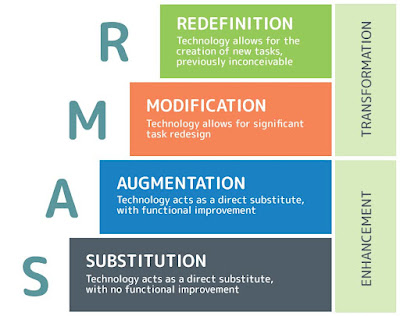My friend, the jazz loving, 1 to 1 pioneer, constructivist evangelist and tech curmudgeon Dr. Gary Stager hates Tech Integration hierarchy models. Why? They never reach high enough. I for one do not hate them. Tech integration hierarchies are a friendly conversation piece that allows and promotes reflection about where technology and pedagogy intersect in the classroom. Gary. Don't throw the baby out with the bath water.
The SAMR model by Dr. Rubin Puentedura is one of the latest Tech Hierarchy models. It has been around since 2010 and I may have written about this before on my blog. I’ll have to check. SAMR stands for Substitution, Augmentation, Modification and Redefinition. Watching this video or reading this article will give you the gist on the SAMR model.
Teachers can use this model to question their technology practices in the classroom. If a teacher is overly reliant on substitution a few things could be happening. The teacher may does not have much technology at the fingertips of their students. Or most of the teacher’s lessons are very traditional. Or the teacher does not have a lot of time to conjure up creative ways to use technology. It could be a combination of all three of the previous issues.

The article linked above tries to emphasize that the SAMR model is not a “ladder to be climbed,” but to match the right level/tool for the job. If teachers are having trouble getting their students engaged, then trying to apply some “modification” or “redefinition” technologies to your classroom might help.
Gary and I may agree when it comes to “Redefinition.” The idea of redefinition has to do with “using technology to create things that were previously inconceivable. The above video talks about the idea of writing and audience. Going from writing on paper to writing in Office 365 is substitution. With things like predictive text and spell check turned on, writing in Microsoft Word or Google Drive “augmenting” that writing experience. Once the student starts to write to a larger audience by posting their writing to a blog so the world can see it is “modification.” These are examples from the video above. The idea of “Redefinition” from the video concerns me. It does not reach high enough. Not in today’s world.
Redefinition is the idea that technology is being used for something previously inconceivable. How about building a model of a human heart that biology students built and print on a 3D printer? What if students created a human heart that people could walk through and learn about? How about a student who want to be an immunologist study the spread of “viruses” in a virtual world like World of Warcraft. How about students working together to build their own AI (Artificial Intelligence) Chatbot? The source code is open source. And then publish the student created Chatbot to the school’s website.
I just do not feel that differentiating the product of a traditional assignment is enough to be called redefinition. Educators should aim high.